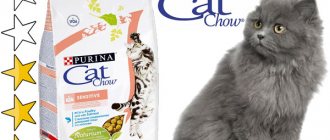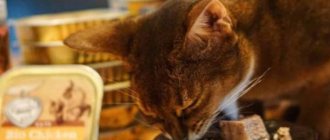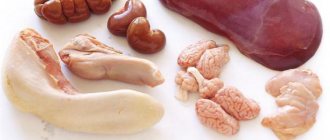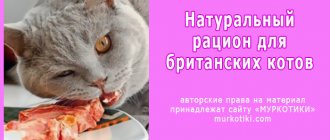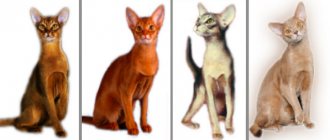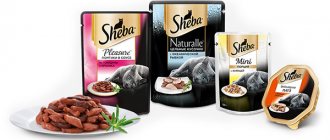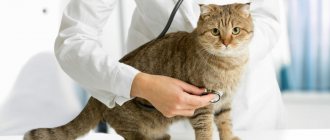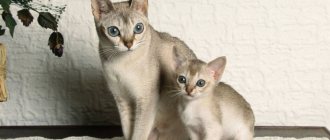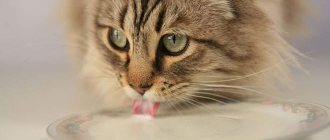What to feed an Abyssinian cat?
With careful care and a nutritious diet, “Abyssinians” (as they are also popularly called) can live for more than 20 years.
The diet for a cat must be selected taking into account several factors: what physical condition the animal is in at the moment; did the veterinarian give any instructions regarding feeding; what did the cat's ancestors eat? age. Do not overfeed your Abyssinian pet: there have been cases when the animal could not stop at the sight of a bowl full of food, and then suffered from digestive tract disorders.
Nutrition should be balanced and contain the required number of vitamins and microelements. The basis of the diet is dry food, and natural products are suitable as treats.
Increased attention should be paid to a pregnant Abyssinian cat: she needs to be fed at least 5 times a day. Include additional vitamins in your pet's diet for the health of future kittens: food with an increased value of nutrients is suitable.
If a pregnant Abyssinian dog begins to shed, this is normal. The body adapts to an unusual role.
It is not recommended to feed pregnant cats fish, but you should treat your pet with milk or kefir as often as possible.
To increase lactation, the expectant mother is advised to give nettle leaves, which must first be doused with boiling water. Feed the cat at her first request, so that in the future the kittens will have enough mother’s milk and will not have to be supplemented with formula feeding. Pet stores sell special food for lactating cats.
After castration and sterilization, food containing fluoride and magnesium should be removed from the cat's diet. Eliminate fish from the menu completely: eating it can lead to the appearance of stones.
On store shelves you can easily find dry food labeled “for sterilized cats,” so give them preference. It is necessary to add fermented milk products, as well as cereals and vegetables to the diet of Abyssinian cats.
Often, people's excessive love for their four-legged pets leads to health problems. In advanced cases, death cannot be ruled out. Take a closer look: is your “Abyssinian” overweight?
If you find it, significantly reduce your usual portion of food. Choose other supplementary foods that are lighter in calories. For cats who are losing weight, you can find a low-calorie mixture in the pet store that replaces dry food. Also give your pet more clean water.
Experts advise not to feed a cat that is in heat for at least one day to calm the body. After the estrus has stopped, the diet should be returned to its previous regime.
There are rare situations when a cat categorically refuses to eat dry food. In this case, the daily portion of regular food should increase by 2-3 times. Bone meal and vitamins (especially calcium) are added to dishes at every meal.
Dry food for Abyssinian cats
It is best to change it from time to time: after all, felines also want variety, and food allergies may also develop. It is better not to save on the cost of food: the health of your pet directly depends on it.
With this diet, the cat should drink 120-150 ml per day. clean water. Refresh the water in the bowl at least 2 times a day. Choose dishes for your cat that are heavy enough so that she has no chance of knocking them over. Let the dry food be in the bowl all the time, even if you are not at home, the cat will always be able to eat it.
Dry food is able to clean the animal’s teeth and does not create microflora for the development of microbes.
It is not recommended to feed the Abyssinian wet food: it can only be used as an addition to the main diet. On store shelves you will find it in the form of pate or pieces of meat in jelly.
Buyers rarely look at the composition of wet food. The effect of psychological deception is triggered: if there are pieces of meat on the packaging, then there must be meat inside. However, this is not the case. Meat components in such feeds contain no more than 4%. If you still want to buy wet food for your pet, opt for premium and higher brands.
Natural nutrition
Natural food should be included in a pet’s diet only when dry food is abandoned - veterinarians do not recommend mixing these two types of food.
Protein is an essential part of the diet of Abyssinian cats. From the meat range, a cat can choose chicken (be careful - animals have allergies), lamb and beef, but it is better to exclude pork: it may contain helminths (parasitic worms). Simply boil your chosen meat and then cut it into small pieces.
Fresh meat is also suitable for consumption, but it should be doused with boiling water before serving. Buy meat products only from reliable suppliers, ask for all accompanying documentation for the products.
If your cat loves fish, give preference to marine species. It is worth starting to introduce a new variety in small portions; if the cat eats food with pleasure and does not have problems with the digestive system, feel free to increase the volumes. Some cats are not averse to eating shrimp.
It is allowed to include fermented milk products in the menu: sour cream, kefir, cottage cheese. But you should not overfeed the “Abyssinian” with “milk” - this can cause an upset stomach.
Sometimes cats love vegetables and fruits. Try offering your pet a piece of carrot, apple or melon. If your cat appreciates this taste and the product does not cause allergies, feel free to include fruit in your diet.
The following products are not allowed into the diet: meat bones and fat in their pure form; smoked meats; salty fish; products containing sugar.
Maintenance, care
Abyssinians can be kept in both city apartments and country houses. Since the animals’ fur is short and the undercoat is light, it is necessary that the premises be warm (temperature at least 23 ° C).
The nature of the Abyssinian cat is such that they love heights, so the pet will like a house on a high leg that serves as a scratching post. Since representatives of the breed are very playful, it is recommended to buy or make special climbing walls. Do not allow your cat to sit on heating appliances, as she may burn her paws.
Walk
If you plan to go to the country, you need to give your pet an injection of the Vakderm shingles vaccine a month in advance. You can only go out for walks under supervision. It's better to buy a harness. Don't let your cat stay in direct sunlight for too long.
Toilet
Abyssinians are distinguished by their cleanliness, so they are demanding about the cleanliness of the toilet. Wood filler in the form of granules is suitable; it absorbs moisture well. It is recommended to purchase a tray with a mesh attached to the top. The best option would be a closed toilet. This will prevent the filler from scattering, because representatives of the breed love to bury their “deeds” with excitement.
Grooming
Combing with a natural bristle brush or a metal comb with fine teeth - once a week. During the shedding period, brush your cat more often using a special rubber glove. To make the fur shine, you can iron it with a silk or suede cloth.
Bathing
Exhibition animals are bathed before each event; the rest need to be washed once every 1-2 months or only during the molting period.
How to properly wash an Abyssinian:
- Degrease the coat using special products. To do this, apply a degreasing paste to dry fur, paying attention to the areas behind the ears, in the armpits, and near the tail.
- After 4 min. rinse off the paste with warm water.
- Then you need to neutralize the degreaser. Apply a special product to damp hair and rub until foam forms.
- After 5-7 minutes, rinse with warm water.
- Apply shampoo for short-haired cats to the fur. You can use tint products. Rinse the shampoo thoroughly, rinsing the coat with clean water at least 3 times.
- If the pet is not participating in the exhibition, you can use the air conditioner. Leave it on for 5 minutes, then rinse off.
To make the fur of an exhibition animal look better, it is recommended to use special sprays instead of conditioner. They are applied only to dry wool.
Abyssinian hair can be dried without using a hair dryer, just wipe it with a towel. To make your coat shine, use a product called “liquid silk.” Apply it to your hands (2-3 drops are enough) and rub it over your pet’s fur. If it is not possible to bathe your cat, use degreasing wipes. Rub the fur for 5-7 minutes, after which you can use other products: glitter, texturizer, etc.
Dental care
It consists of cleaning – once every 2 weeks. The pet is accustomed to the procedure starting at the age of 3-4 months. Use a children's toothbrush and a special paste that does not need to be washed off. Place the animal with its back to you, open its mouth with your left hand, and brush your teeth with your right.
Nail care
Trimming – once a week, using a nail clipper. Take your pet's paw and press on the pad: the cat will release its claws. Carefully trim the sharp, transparent ends without touching living tissue. If blood appears, treat the area with hydrogen peroxide.
Ear care
Inspection – once a week. If dark discharge appears, remove it with a cotton swab and moisten it with a special lotion. You can buy wipes designed for cleaning pet ears.
Eye care
Provides regular inspection. If discharge appears, wash your cat's eyes with a special solution or strong tea.
Breed Features
To raise a healthy Abyssinian kitten, before choosing a diet for their pet, owners must study and know the characteristics of the breed. Abyssinians are a rather fastidious breed to care for and maintain.
Important! Unlike other cat breeds, Abyssinians are more prone than others to intestinal disorders and food (nutritional) allergies. Therefore, the choice of diet and nutrition must be approached with all responsibility.
Abyssinian cats are inquisitive, active, energetic, playful and very sociable. These are clean and tidy animals. They have a sharp mind, high intelligence, and a well-developed hunting instinct. They rarely act out of spite; they are not vindictive, but touchy.
Abyssinians are unobtrusive, but require attention, affection, and respect from their owners. If you treat your cat with all respect and give it warmth and care, your pet will be a loyal friend, companion and will gladly share your interests.
Since Abyssinian cats are not large breeds, they should be fed often, but in small portions. By the age of one year, the kitten must be accustomed to a certain diet and diet.
Historical reference
The breed appeared on the territory of today's Ethiopia more than 9 thousand years ago. From there these cats came to Egypt and became domestic cats. Representatives of the breed were brought to Europe on one of the ships of the British military expedition (in the 19th century). The Abyssinian first appeared at the exhibition in 1871, taking 3rd place. The breed was officially recognized in 1882, and a standard was drawn up in 1889. In 1931, the first monobreed exhibition took place, where 20 individuals were presented.
In 1970, the Abyssinians became known throughout the world. By now, the appearance of the animals has changed somewhat: the appearance has become more graceful, the skeleton is lighter, the ears are larger. In America, the breed is on the list of the most popular. The owners include many celebrities: Nicole Richie, Chloë Sevigny, David Bowie, Nicolas Cage. In Russia, the first Abyssinian appeared only in the 90s. The beginning of popularization was facilitated by the article of the Moscow breeder N. Tyrdanova, “The Captivating Charms of the Abyssinians,” published in the magazine “Friend” (2002). However, these cats are still considered quite rare in the Russian Federation.
Choosing a place and dishes
For a comfortable stay, Abyssinian cats need to equip a house for sleeping and relaxing. It is placed in a secluded place, where the kitten spends the most time. You cannot place a cat house near household heating appliances or in drafts.
Important! The choice of place and dishes depends largely on age and character. Individual characteristics of your pet.
As for bowls, a cat should have 2-3 bowls. Two are for food. One may be deeper and wider, the second with several compartments. The main thing is that the kitten’s whiskers do not rest against the sides during the meal. For water, choose a deeper bowl so that your pet can drink comfortably.
You can buy special bowls for kittens. But remember that animals grow quickly, so you can give food to a small pet from bowls for adult cats.
Bowls can be:
- made of durable plastic;
- ceramics, clay;
- stainless steel
Important! Do not use aluminum containers for feeding cats or drinking water. Aluminum releases harmful chemicals, especially when exposed to high temperatures.
Set up a place where your pet will eat. This should not be a pass-through place. If there are other animals in the house, place bowls on the nightstand, windowsill, or other elevated surfaces. No one should disturb the kitten while eating.
Place the water bowl further away from the food bowls. Residues of food should not get into drinking water. This is unsafe for the pet's health.
Keep your cat's dishes clean and rinse them with clean running water after each feeding without using household chemicals.
What to feed an Abyssinian kitten
Feeding Abyssinian cats must be approached very responsibly. It is especially important to choose a diet for kittens of this breed. Nutrition should be complete, fully balanced, fortified and varied with a natural type of feeding.
You can feed Abyssinian kittens:
- natural fresh products specially prepared for your pet (natural diet);
- high quality ready-made industrial feeds (ready-made rations).
You can also choose a combined or mixed diet for Abyssinians. But remember that each diet has both its advantages and disadvantages. Therefore, when choosing a diet for your furry pet, take into account the speed of its development, activity, physiological, individual, breed characteristics, and health status.
Mixed feeding
Combining natural and industrial cat food is not prohibited, but has a number of features. They relate to maintaining a balance of nutrients in the diet. As a rule, the owner gives the cat dry food on weekdays, and on weekends pampers it with something tasty and natural.
In this mode, it is difficult to keep track of the diet, so the menu often goes beyond acceptable limits.
When feeding a mixed diet, you need to monitor the physical condition of Abyssinian cats. If any indicators deteriorate, a combination of diets is excluded and one type of nutrition is left.
Natural diet
Natural food, according to many breeders and veterinarians, is the best option for feeding cats. But in the case of the Abyssinian breed, it is very important to achieve the maximum balanced natural diet. This breed is prone to allergies, intestinal disorders, and gastrointestinal diseases.
Benefits of a natural diet:
- the owner is confident in the quality and freshness of food;
- the pet receives a varied menu;
- natural food is somewhat cheaper than feeding with high-quality feed;
- You can choose the ideal diet for your pet, taking into account his taste preferences.
Prohibited foods
The following foods should not be included in the diet of Abyssinian cats:
- pork in any form;
- egg white;
- fats, skin, bones of birds;
- sweet fruits with a high juice content;
- dried, smoked fish and all types of freshwater fish in raw form;
- sugar-containing products and sugar substitutes, caffeine and stimulants;
- baked goods in any form;
- mushrooms.
The main rule is that you cannot feed your Abyssinian cat anything potentially dangerous. Mushrooms cause allergies, chicken skin with a fatty layer leads to weight gain, and raw fish is a breeding ground for worms.
Ready diet
With a ready-made diet, Abyssinian kittens are fed wet, dry, semi-moist industrial food, canned food, and high-quality pates. The prepared diet should be varied. You should not feed your pet only, for example, dry food or wet food. Combine dry pads with canned food, pates, and treats for kittens.
Advantages of ready-made diets:
- no need to waste time preparing a varied menu for the cat;
- the brand line includes food for kittens of various age groups;
- dry food has a long shelf life;
- the manufacturer indicates the approximate daily allowance by age on the packaging;
- large selection of flavors.
The line of well-known brands also includes products for weakened animals, for kittens with a sensitive gastrointestinal tract, and pets prone to food allergies.
The best food for Abyssinian kittens:
High-quality feed has a balanced composition and contains all the necessary nutrients, vitamins, microelements, and amino acids. Holistics are intended for nutrition of Abyssinian kittens with sensitive digestion. Contains probiotics and enriched with B vitamins.
Treats for Abyssinians
Encouragement through feeding is an important point in the education and socialization of the Abyssinian cat. Pet food manufacturers produce various treats in the form of sticks or small cookies.
Experts do not advise unconditionally trusting assurances of the safety of these food additives. To rule out allergies, indigestion and other troubles, you need to feed the cat a small piece and see how the body reacts.
It is better to choose one of the ingredients from the main menu that the Abyssinian cat likes most, and then use it for incentive feeding:
- Some cats do well with small pieces of raw meat.
- Boiled fish will also make the Abyssinian rub against the owner’s legs.
- Almost all animals absolutely love cheese.
For Abyssinians whose diet consists of natural products or wet industrial food, a treat made from dry granules is well suited. In this case, the problem of a balanced diet and food safety is solved by itself - a small addition of your favorite complementary foods will not harm the cat’s health.
The Abyssinian cat breed belongs to a small group, representatives of which often live up to 20 years of age. A properly selected diet plays a big role in longevity - it is impossible to raise a healthy and active cat without daily monitoring of its nutrition.
Sample menu by age
Feeding Abyssinian kittens implies a clear organization of nutrition in accordance with the age of the kitten. Therefore, we present an approximate menu by age. Little kittens feed strictly according to the clock. As they grow older, the frequency of feedings decreases, but the volume of portions increases. Until 9-11 months, the pet should eat according to a set schedule and receive the same diet.
Feeding schedule and frequency:
- From birth to two weeks of age, kittens eat 9-10 times a day without a break for night sleep. They need to be fed every two hours. The baby should drink about 3-4 ml of milk at a time.
- From 14 to 18 days - 8-9 times a day without a break for night sleep. Approximately 5-7 ml of milk formula, milk substitute, is given.
- From 19 to 30 days - seven to eight times a day and one night feeding. Feed 10 ml of mixture.
- From one month to two – 7 times a day.
- From 2 to 3 months, kittens need to be fed 6-7 times a day.
Up to a month
The main nutrition of kittens from birth to one month is colostrum and mother's milk. With it, babies receive nutrients and initial immunity (protective antibodies).
If for some reason the kittens are left without a mother cat or the lactating female does not have enough milk, the owners take care of the small pets. Ideally, try to find another nursing cat to care for and feed the newborn kittens.
If this is not possible, the following is used for artificial feeding:
- formulas for infants without sugar and additives (Nutrilon, Malyuk);
- industrial cat milk substitutes (Babycat Milk from Royal Canin,
- Katzenmilch, Hartz, Gimpet Cat-Milk).
You can also prepare mixture for artificial kittens yourself using specially developed recipes. For Abyssinians, a Scott or Tailing mix is ideal . Recipes can be found on thematic forums or websites.
Vitamins and supplements
A kitten's growing body must receive all the vitamins and mineral supplements necessary for health and development. There are complexes on sale designed for kittens starting from 2-3 months of age. It is best to use complex preparations (Gamavit, Tetravit, Trivit). At the same time, we note that vitamin supplements are necessary when keeping a pet on a natural diet. High-quality industrial feeds have a completely balanced composition and already contain all useful substances.
From available means, the diet is enriched once a week with fish oil (one drop for each feeding), dry yeast, and meat and bone meal.
Fresh drinking water should always be freely available to the animal, regardless of what the Abyssinian kitten’s diet is. Change the water twice a day. Keep the bowl clean.
Use settled, filtered soft water or still bottled water for your Abyssinian kitten.
Health, tendency to disease
Abyssinians are distinguished by fairly good health, however, there are problems of hereditary diseases:
- Progressive retinal atrophy. Manifested by progressive degeneration of photoreceptors. The disease is incurable and ends in loss of vision.
- Renal amyloidosis. The cause is the accumulation of amyloid protein in the kidneys and other organs of the body. The disease leads to kidney failure.
- Deficiency of pyruvate kinase (an enzyme found in red blood cells), which causes anemia.
As a rule, these pathologies appear in older animals.
Hyperesthesia syndrome, which is neurological in nature, is often observed. The pathology is expressed in the fact that the cat intensively takes care of itself. The consequence is hair loss. Other diseases characteristic of the breed:
- dislocation of the kneecap;
- hip dysplasia;
- gingivitis (inflammation of the gums).

